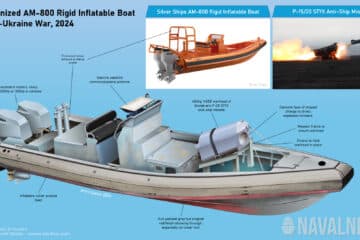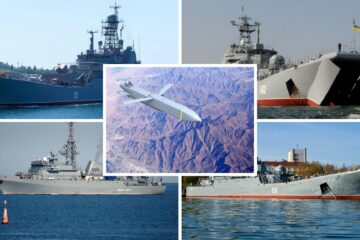Talking at the launch of the UK/Norway/Ukraine Maritime Capability Coalition at Admiralty House on 11 December, Vice Admiral Oleksii Neizhpapa discussed the need to build Black Sea security, and how Ukraine will use the new coalition to develop a future navy that underpins Ukrainian – and wider regional – security and economic prosperity.
Despite limited asset numbers, Ukraine’s naval forces have performed effectively in the war with Russia, which broke out in February 2022. The navy has employed anti-ship missiles and uncrewed systems to conduct a sea denial campaign in the Black Sea, and its marine forces have been used to project power ashore through amphibious raiding. According to Ukraine’s defence ministry, 15 Russian vessels have been destroyed and 12 damaged.
“Events today demonstrate that Russia is not going to stop the brutal war against Ukraine,” said Vice Adm Neizhpapa. “If we lose the sea, there will be no Ukraine.”
Vice Adm Neizhpapa underlined the importance of the new coalition, and other support the navy receives, for the sustained effort in building the navy’s capacity to secure Ukrainian interests at sea both during and beyond the war.
“The combat potential of the navy will gradually grow and strengthen. This will enable the navy to effectively protect Ukraine’s sovereignty, economy, and people. “A powerful and capable navy is not only a tool to deter Russian aggression from the sea, but also a guarantee of the prosperity of our country and security in the region,”
Vice Adm Neizhpapa, Chief of the Ukrainian Navy
Through the coalition arrangement, the Ukrainian Navy will receive two ex-UK Royal Navy (RN) Sandown-class minehunters, Grimsby and Shoreham (renamed Chernihiv and Cherkasy); 23 onshore/offshore raiding craft; and 20 Viking amphibious vehicles. The decision to transfer the two minehunters was taken prior to the war’s outbreak.
The coalition also focuses on training Ukrainian Navy personnel, with the RN delivering training for the two minehunter crews. This enabled the ships to be prepared quickly for operations. “These are two ships that are ready today to conduct a mission,” Vice Adm Neizhpapa said.
Notwithstanding the training requirements, buying ships off the shelf can provide capability more quickly, he added.
The two ships will not be able to sail into the Black Sea, because Turkey invoked the 1936 Montreux Convention at the start of the war; this closed access from the Mediterranean Sea via the Bosporus and Dardanelles straits, except for naval ships already homeported in the Black Sea. However, Vice Adm Neizhpapa said, the ships will be busy when the war is over. “The Black Sea is a dangerous place in terms of mine security, and we need much time to make it secure. These ships will do this job,” he continued. “For the time being, we will use uncrewed systems – which we can deliver by other ways – to provide mine security in the Black Sea.”
Whether using crewed or uncrewed platforms, sanitising the Black Sea’s sea lines of communication (SLOCs) is critical for Ukraine, to ensure that export of key commodities like grain and steel can continue; it also enables freedom of navigation across wider Black Sea waters.
The future operational role for the minehunting ships reflects the Maritime Capability Coalition’s focus on providing capability not just in the near term but over a longer period. “We have created a plan out to 2035,” said Vice Adm Neizhpapa.
Naval News understands that Ukrainian Navy capability priorities out to the 2035 timeframe include long-range strike, mine-countermeasures, and shipborne air-defence systems.
The provision of capabilities like the Viking vehicles and the raiding craft will enhance the littoral and amphibious capabilities of the navy’s marine forces.






